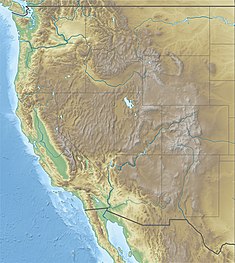Echo Park Dam
| Echo Park Dam | |
|---|---|

Steamboat Rock, near the Echo Park damsite
|
|
|
Location of the proposed Echo Park Dam
|
|
| Country | United States |
| Location | Northwestern Colorado |
| Coordinates | 40°32′43.45″N 109°00′30.35″W / 40.5454028°N 109.0084306°WCoordinates: 40°32′43.45″N 109°00′30.35″W / 40.5454028°N 109.0084306°W |
| Status | Unbuilt |
| Owner(s) | U.S. Bureau of Reclamation |
| Dam and spillways | |
| Type of dam | Concrete thick arch |
| Impounds | Green River |
| Height | 529 ft (161 m) |
| Reservoir | |
| Total capacity | 6,400,000 acre feet (7.9 km3) |
| Normal elevation | 5,500 ft (1,700 m) |
| Power station | |
| Installed capacity | 200 MW |
| Split Mountain Dam | |
|---|---|
| Country | United States |
| Location | Northeastern Utah |
| Status | Unbuilt |
| Owner(s) | U.S. Bureau of Reclamation |
| Dam and spillways | |
| Impounds | Green River |
| Height | 118 feet (36 m) |
| Reservoir | |
| Normal elevation | 5,048 ft (1,539 m) |
Echo Park Dam was proposed in the 1950s by the U.S. Bureau of Reclamation as a central feature of the Colorado River Storage Project. Situated on the Green River, a major tributary of the Colorado River, the dam was proposed for the Echo Park district of Dinosaur National Monument, flooding much of the Green and Yampa river valleys in the monument. The dam was bitterly opposed by preservationists, who saw the encroachment of a dam into an existing national park as another Hetch Hetchy, to be opposed as an appropriation of protected lands for development purposes. A compromise led to the abandonment of the Echo Park project in favor of Glen Canyon Dam on the main stem of the Colorado in lands that were not at that time protected.
The project was first proposed in 1941. Dinosaur National Monument was, at the time of its designation in 1915, a small 80-acre (32 ha) park unit focused on the dinosaur fossil beds discovered along the Green River in 1909. The monument was expanded in 1938 to 200,000 acres (81,000 ha), encompassing the canyon networks of the Green and Yampa upstream from the dinosaur quarry. The newly added areas were little known to the public and to the Park Service, and the Park Service initially did not oppose the dam plans, having allied itself with the Bureau of Reclamation to develop Boulder Dam National Recreation Area (later Lake Mead National Recreation Area and other reservoirs as public recreation facilities. The Park Service finally came out against the proposal in 1950, with director Newton B. Drury in opposition to the position of Secretary of the Interior Oscar L. Chapman, whose department controlled both the Park Service and the Bureau of Reclamation. Drury stated in the 1950 Park Service annual report that reservoir projects would "destroy or impair the beauty and interest" of the national parks. Drury, a Republican in a Democratic administration, resigned in 1951, leading to criticism of Chapman for forcing Drury out. Drury was followed for eight months by Arthur Demaray, then by Conrad Wirth. Wirth took a less confrontational approach, partly under orders from Chapman to make the disagreement less public. Wirth was an advocate of public recreation lands associated with Reclamation projects, and suggested that Echo Park could become a National Recreation Area once flooded with a reservoir.
...
Wikipedia

